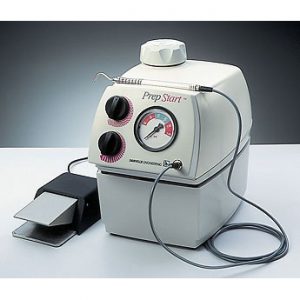Air Abrasion, Drill-less Drilling. How does it work?
 As they say every thing old is new again. Air abrasion is an old technology that has come back into dentistry with the advent of porcelain fillings. Yes it is literally like sand blasting the tooth away. A very small high pressure stream of air and sand particles precisely removes tooth structure and decay. The sand is actually one of the biggest disadvantages because it can make a sandy mess. Initially air abrasion was simply ahead of its time. The air abrasion process did not work well when preparing teeth for silver fillings because it creates an irregular surface that did not work well with amalgam fillings materials. Because of this drawback it never became popular until the introduction of bonding and composite fillings. The irregular surface produced by air abrasion creates more surface area and a better bond, perfect for these newer materials.
As they say every thing old is new again. Air abrasion is an old technology that has come back into dentistry with the advent of porcelain fillings. Yes it is literally like sand blasting the tooth away. A very small high pressure stream of air and sand particles precisely removes tooth structure and decay. The sand is actually one of the biggest disadvantages because it can make a sandy mess. Initially air abrasion was simply ahead of its time. The air abrasion process did not work well when preparing teeth for silver fillings because it creates an irregular surface that did not work well with amalgam fillings materials. Because of this drawback it never became popular until the introduction of bonding and composite fillings. The irregular surface produced by air abrasion creates more surface area and a better bond, perfect for these newer materials.
Does air abrasion hurt?
Air abrasion presents several advantages:
1 Perhaps the most important is that small cavities can be prepared without anesthetic. The high pressure stream of air and sand particles does not upset the nerve like a drill because it does not produce as much heat or vibration.
2 The air abrasion process is almost silent so that you do not have to listen to the high pitched noise of the drill.
3 The surface created by air abrasion significantly increases the bond strength of procelin fillings.
 Can I have all my dental work done with air abrasion?
Can I have all my dental work done with air abrasion?
If the decay has significantly invaded the tooth even the air abrasion process can cause sensitivity and even pain. At that point it is best to use local anesthetic and the procedure can be completed either with a drill or air abrasion. If there is significant decay the softness of the decay prevents sand blasting from efficiently removing the decay. Removing old silver fillings with air abrasion produces unwanted amalgam dust so that most replacement dental work is better done with a drill. Air abrasion cannot be used for major dental work like crowns or onlays
When can air abrasion be used?
We have used air abrasion for over 10 years and have found it works best in very small cavities ers, when a tooth has a chip within the enamel or in repairing composite fillings. Air abrasion can produce excellent, pain free fillings in the right situations.
